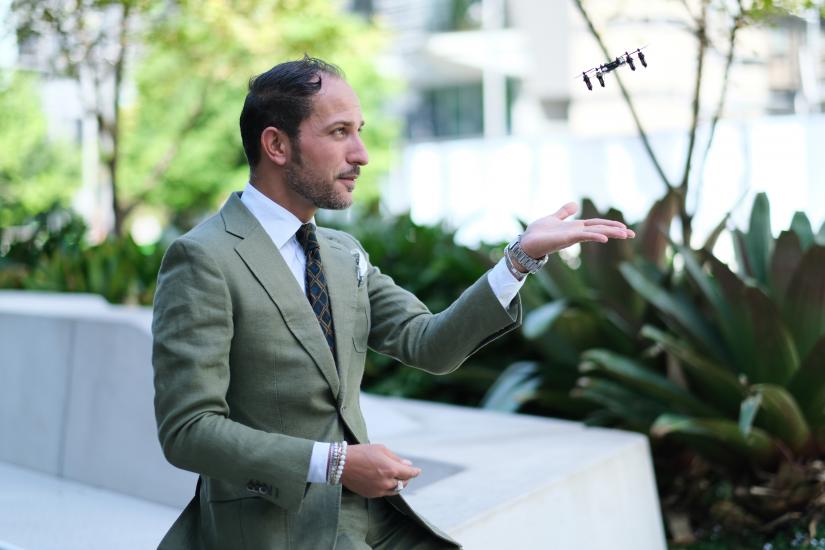Professor Matteo Convertino is fascinated by the broad and complex organisation of nature. He visited UTS under the Faculty KTP (Engineering and IT) Visiting Fellow program.
A flock of autonomous drones

Professor Matteo Convertino at UTS. Image: Amos Wong
Inspired by the natural world’s beauty and complexity, he believes that just as the environment surrounding us constantly develops, so do opportunities to learn more about how nature works.
Convertino came to UTS in January as a Visiting Fellow from Hokkaido University to research biomimicry and how it can be applied to drones; his field, biocomplexity, involves the study of ecology and evolution of socio-ecological systems, as well as defining control solutions for these systems. Convertino was hosted by Industry Associate Professor Justin Lipman from the Advanced Analytics Institute as a Visiting Fellow under the Faculty KTP (Engineering and IT) scheme.
The objective of their research is to create the first autonomous, self-learning flock of drones that derive behavioural rules from the sensing of nature.
Originally specialising in hydrodynamics and hydrology, Convertino was drawn to the field of biocomplexity, where data is noisier—and more limited.
On the surface it may seem hard to understand patterns and processes, but this 'data poor' investigation is more fun and rewarding because it is the reality of basic science research.
He believes that data science is more about understanding what information should be collected, rather than using all the data available—a different perspective to what he terms ‘classical deterministic engineering.’
But back to the drones.
They will not be completely independent, Convertino explains. “They are given an initial point and an end point; whatever they do in the middle is up to them as a function of what they sense.” The objective was to identify the best model of collective behaviour that enables them to self-organise and accomplish their mission given three constraints: initial destination, final destination, and energy limitation.
Convertino says the UTS experience was invaluable.
Professionally, the most interesting thing for me it has been the ability to formulate novel and unexpected thoughts or lines of research with different people.
Through the Faculty KTP program, institutions like UTS and Hokkaido University can support and leverage research links. Convertino met experts in bioreactors and water quality, microbial ecology and microfluidics, socio-ecological scientists, and reef ecologists, whose work complemented his research into the microbiome and ecosystem health.
This program gave me the opportunity to make this collaboration more solid and to find other research collaborations; in the long term, such collaborations can strengthen topics and applications of mutual interest of the universities and countries involved.
In the case of Japan and Australia, this could be particularly relevant to the fields of natural resources, natural extremes, agriculture, and technology.
Convertino’s three weeks in Sydney have inspired abundant plans for publications and funding opportunities, but like natural selection, only the best will prevail. The focus is to see his research result in practical solutions with impact.
Autonomous drones can be used to release targeted chemicals on mosquito populations carrying viruses like Dengue or Yellow Fever in remote areas; monitor regions susceptible to natural hazards such as floods and fires, where multiple drones can sense where monitoring should be targeted and concentrated; and track soil moisture and plant health for agriculture.
"The collective motion model can be applied to other robotic agents, such as nanobots for drug delivery within the body,” Convertino adds, “but drones are a good subject because they are easy, and they are popular."
Going the other way, studying the collective function of animals or engineered drones can be useful to design single agent disturbance models—drones able to detect a swarm of real birds and, for example, keep them away from an airport. The application of autonomous drones is limitless.
